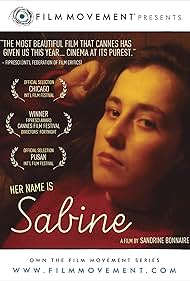A sensitive portrait of Sabine Bonnaire, the autistic sister of the french actress Sandrine Bonnaire.A sensitive portrait of Sabine Bonnaire, the autistic sister of the french actress Sandrine Bonnaire.A sensitive portrait of Sabine Bonnaire, the autistic sister of the french actress Sandrine Bonnaire.
- Awards
- 3 wins & 4 nominations
- Director
- Writers
- All cast & crew
- Production, box office & more at IMDbPro
Storyline
Did you know
- ConnectionsReferences Finding Nemo (2003)
Featured review
This deeply personal documentary tells the saddest of stories--not just because we feel sorry for actress Sandrine Bonnair's mentally abnormal sister but because we can imagine how she might have turned out differently. That's because for decades Sandrine has been filming Sabine. However strange, unpredictable, and angry she may have been, she had intelligence and talent, could read and write, taught herself English and Bach on the piano, and had a capacity for joy. She loved America and as a young person Sandrine took her there. She could travel! She was so happy!! And then, today, at 38, and institutionalized, she weeps. For joy, she says. But she is a devastated person, beaten down by five years in a psychiatric hospital, heavily medicated but undiagnosed, insecure, repetitive, sluggish, 70 pounds heavier, drooling and with the shakes.
After Michael Momore's Sicko, which cites a WHO study of a few years ago that ranks France first in the world for medical care, and Julian Schnabel's The Diving Bell and the Butterfly, which shows the extraordinary attentiveness of the staff dealing with a totally paralyzed man, it's a shock to learn that France is very lacking in specialized centers for the care of people like Sabine. But what are people like Sabine? Her famous sister and a doctor worked to have this place set up in Charente. There, it appears, finally Sabine has been diagnosed as psychologically infantile with autistic behaviors.
In her narration, Bonnaire tells us that Sabine was always very close to her sisters. She went to a special school, but then her parents put her in the same school as her siblings. But that led to trouble. Her odd behavior led the other students to tease her and call her "crazy Sabine," and she began biting her hands and scratching her face and taking off her clothes in the school ground. So the family took her out of school. At home, she was active and productive, knitting for family members, making dolls, and studying on her own. But one by one the sisters left home, which was on the outskirts of Paris. Judging by Sabine's behavior now, she must have felt abandoned, and she took out her rage on her mother. And this eventually led to the psychiatric hospital and all the damage that was done to her there.
We see the home movies. In them Sabine is almost as pretty as Sandrine. She is thin and active. She smiles a lot. And on the two sisters' journey to America she is bursting with happiness. She dances. She may have problems, but she is a vibrant young woman.
There are just a few other people cared for at the Charente center, including a retarded girl and a 30-year-old man with severe motor disabilities and frequent epileptic seizures. Sandrine focuses on them and on the caring staff members who stay with them through the day. We see flashes of the old happiness in Sabine when they go to a swimming pool, and when Sandrine shows her a DVD of their bygone trip to the US, Sabine weeps, but says they are "tears of joy." Alas, though, too often Sabine is sluggish, staring into space, or repetitively asking Sandrine if she is really going to stay there till evening, if she is really going to come back the next day.
As Lisa Nesselson writes in her Variety review, this documentary " is intimate but never transgressive, informative but never clinical. " Of course: this is a study, a lesson, but most of all an act of love and sisterly devotion.
Winner of the FIPRESCI Award at the Cannes Film Festival 2007. Sandrine's Letter of Intent for the film (which can be found online) provides a detailed chronology of her sister's life. The actress has worked with many important French directors, including Pialat, Techine, Sautet, Rivette, Chabrol, and Leconte
Shown in Paris from January 30, 2008, this documentary , Her Name Is Sabine/Elle s'appelle Sabine is part of the Rendez-Vous with French Cinema at Lincoln Center, New York, February 29-March 9, 2008.
After Michael Momore's Sicko, which cites a WHO study of a few years ago that ranks France first in the world for medical care, and Julian Schnabel's The Diving Bell and the Butterfly, which shows the extraordinary attentiveness of the staff dealing with a totally paralyzed man, it's a shock to learn that France is very lacking in specialized centers for the care of people like Sabine. But what are people like Sabine? Her famous sister and a doctor worked to have this place set up in Charente. There, it appears, finally Sabine has been diagnosed as psychologically infantile with autistic behaviors.
In her narration, Bonnaire tells us that Sabine was always very close to her sisters. She went to a special school, but then her parents put her in the same school as her siblings. But that led to trouble. Her odd behavior led the other students to tease her and call her "crazy Sabine," and she began biting her hands and scratching her face and taking off her clothes in the school ground. So the family took her out of school. At home, she was active and productive, knitting for family members, making dolls, and studying on her own. But one by one the sisters left home, which was on the outskirts of Paris. Judging by Sabine's behavior now, she must have felt abandoned, and she took out her rage on her mother. And this eventually led to the psychiatric hospital and all the damage that was done to her there.
We see the home movies. In them Sabine is almost as pretty as Sandrine. She is thin and active. She smiles a lot. And on the two sisters' journey to America she is bursting with happiness. She dances. She may have problems, but she is a vibrant young woman.
There are just a few other people cared for at the Charente center, including a retarded girl and a 30-year-old man with severe motor disabilities and frequent epileptic seizures. Sandrine focuses on them and on the caring staff members who stay with them through the day. We see flashes of the old happiness in Sabine when they go to a swimming pool, and when Sandrine shows her a DVD of their bygone trip to the US, Sabine weeps, but says they are "tears of joy." Alas, though, too often Sabine is sluggish, staring into space, or repetitively asking Sandrine if she is really going to stay there till evening, if she is really going to come back the next day.
As Lisa Nesselson writes in her Variety review, this documentary " is intimate but never transgressive, informative but never clinical. " Of course: this is a study, a lesson, but most of all an act of love and sisterly devotion.
Winner of the FIPRESCI Award at the Cannes Film Festival 2007. Sandrine's Letter of Intent for the film (which can be found online) provides a detailed chronology of her sister's life. The actress has worked with many important French directors, including Pialat, Techine, Sautet, Rivette, Chabrol, and Leconte
Shown in Paris from January 30, 2008, this documentary , Her Name Is Sabine/Elle s'appelle Sabine is part of the Rendez-Vous with French Cinema at Lincoln Center, New York, February 29-March 9, 2008.
- Chris Knipp
- Feb 21, 2008
- Permalink
Details
- Release date
- Country of origin
- Official site
- Language
- Also known as
- Her Name Is Sabine
- Production company
- See more company credits at IMDbPro
Box office
- Gross worldwide
- $161,796
- Runtime1 hour 25 minutes
- Color
- Aspect ratio
- 1.37 : 1
Contribute to this page
Suggest an edit or add missing content

Top Gap
By what name was Elle s'appelle Sabine (2007) officially released in Canada in English?
Answer















